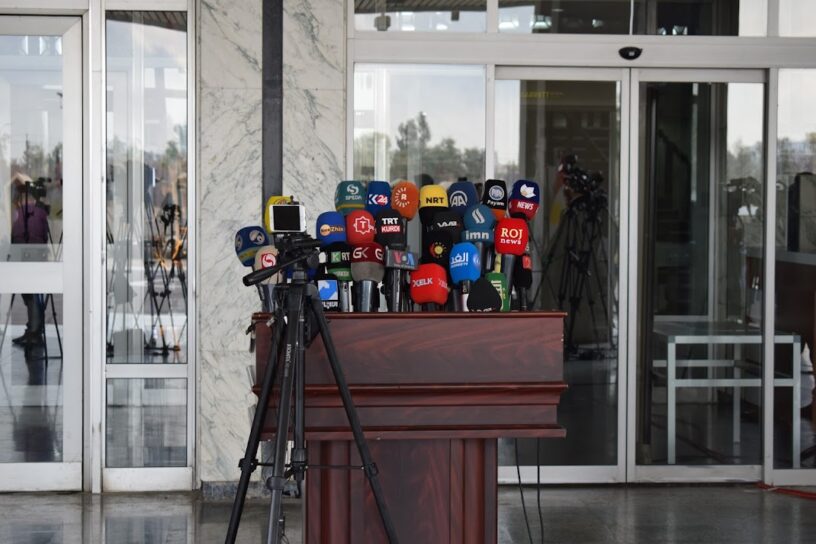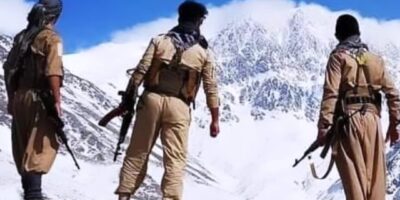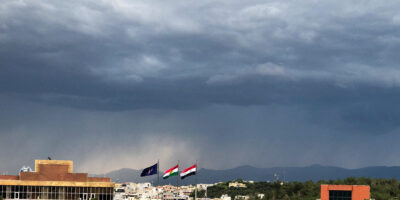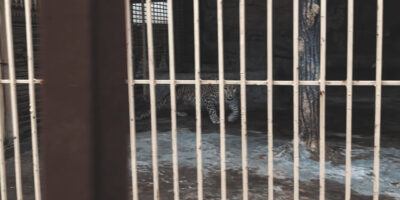Freedom of the press is protected in Iraq’s Kurdistan Region under both federal and regional law, but is frequently ignored in practice by the authorities. With new violations happening all the time, it can be hard to make sense of what incidents may mean in a coherent and useful way. However, a close look at when and where violations occur, what journalists and outlets are targeted, and by whom reveals much about the Region’s highly charged nexus of politics and media.
There were at least 431 violations against 301 journalists and media outlets in the Kurdistan Region in 2022, according to the annual report prepared by the Metro Center for Journalists’ Rights and Advocacy. This amounted to 137 separate incidents covering Duhok, Erbil, Sulaimani, Halabja, Kirkuk, and Nineveh governorates, with many incidents involving multiple violations.
There were 195 preventions of coverage, 68 confiscations of journalistic equipment, 64 detentions without a lawful warrant from a judge, 46 threats or “humiliations,” and 26 beatings or physical attacks described in the watchdog’s report.
Additionally, Metro Center said that 16 journalists were forced to sign a pledge not to report on an event, six media broadcasts were disrupted by an electronic attack, four journalists were arrested under a judicial order, the homes of three journalists were raided by the security forces, two media offices were targeted in missile attacks, and one media outlet was forcibly shut down.
This represents an increase over the 353 violations in 2021, 385 in 2020, and 231 in 2019. An examination of Metro Center’s reports for the past decade shows an upward trend since 2013, making it clear that restricting press freedom is a well-entrenched dynamic that is also getting harsher.
The Nesar Record has analyzed the data from Metro Center’s 2022 report in an effort to identify additional trends to those outlined by the watchdog, including geographic and monthly distribution, identity of the perpetrator and their apparent political affiliation, and the outlets that were targeted and their political affiliations. This analysis is based on the 137 incidents, rather than individual violations. It is intended as a useful contribution to visualizing the current status of press freedom in the Kurdistan Region.
It is, however, limited by the data available, which undercounts the number of violations. The Nesar Record is aware of other incidents that are not included in Metro Center’s review. In many cases, press freedom groups rely on journalists to self-report violations against them. Some choose not to do so, for a variety of reasons ranging from a desire to avoid retaliation to a personal assessment that the incident did not affect their work. Therefore, Metro Center’s report is an incomplete — albeit valuable — approximation, but the challenges faced by journalists in the Kurdistan Region are, in fact, more serious than the data suggests.
Where are violations taking place?
There was remarkable geographic balance between incidents reported across the Kurdistan Region, with about a third of incidents occurring in each of the three largest governorates. Erbil had the most incidents with 46; Duhok and Sulaimani had 43 incidents each. Halabja, by far the smallest governorate, was an outlier with just three incidents. There was also one incident recorded in each of Nineveh and Kirkuk governorates, which lie outside of the control of the Kurdistan Regional Government (KRG), but involved reporters from outlets based in the Kurdistan Region.
There are two broad zones of political control in the Kurdistan Region, with the Kurdistan Democratic Party (KDP) dominant in Duhok and Erbil governorates and the Patriotic Union of Kurdistan (PUK) in charge in Sulaimani and Halabja governorates. The former is often referred to as the “Yellow Zone” and the latter as the “Green Zone,” in reference to the colors adopted by the KDP and the PUK respectively.
About two-thirds of incidents (87) took place in the KDP’s Yellow Zone and one-third (48) in the PUK’s Green Zone. Some cities are located in one governorate, but within the rival ruling party’s zone of control. Koya is the most notable example of this: it is a part of Erbil governorate, but most of the district lies in the Green Zone. This nuance affected the data, with two incidents taking place in Koya city included in the Green Zone total.
This data suggests that the violations of journalists’ rights occur more frequently in areas controlled by the KDP than the PUK. However, it is clear that incidents occur regularly in PUK areas as well.
In December, The Nesar Record reported on journalists’ perception that press freedom conditions were deteriorating under the PUK during autumn 2022. This anecdotal evidence is confirmed by the data. Over the first six months of last year, there were an average of two press freedom incidents per month in the Green Zone; this increased to an average of 5.8 incidents per month in the second half of the year.
In the Yellow Zone, there was an average of 7.8 incidents per month in the first half of the year, which declined slightly to 6.5 per month in the second half.
Overall, August was the most dangerous month for journalists in the Kurdistan Region last year, with 30 incidents. The bulk of those were related to a crackdown on journalists and activists ahead of and during a protest organized by the New Generation Movement, an outspoken opposition party. On July 31, the party’s leader, Shaswar Abdulwahid, called for demonstrations across the Kurdistan Region to take place on August 6. In response, the authorities launched a wave of arrests, in which members of parliament were also detained.
Between August 5 and 6, there were 22 incidents of violations against journalists across the Kurdistan Region, including thirteen involving security forces affiliated with the PUK and nine involving KDP-linked forces. Metro Center identified journalists from NRT, KNN, Westga, Diplomatic, Radio Deng, Rastnews, Kurdnews, Fourth Power, Rachlaken, BMC, Sharpress, and several unaffiliated reporters as being targeted. The arrests contributed to reduced coverage of the protest.
“Authorities in Iraqi Kurdistan have reached a new low with their detention and harassment of reporters and media workers seeking to cover civil unrest,” said CPJ’s Middle East and North Africa program coordinator Sherif Mansour in a press release about the arrests.
“Iraqi Kurdistan was once a haven for the free press in the Middle East but now the region is a prime perpetrator of press freedom violations,” he added.
Who was responsible for violations against journalists?
The perpetrators of violations against journalists in the Kurdistan Region fell into seven broad categories: KDP-controlled security forces, government or party officials affiliated with the KDP, PUK-affiliated security forces, government or party officials affiliated with the PUK, civilians, actors outside the Kurdistan Region, and those whose identities are unknown. Incidents at protests were coded as violations conducted by security forces unless otherwise noted, even if members of the security forces were in plainclothes or civilian attire.
Security forces operating in areas controlled by the KDP were responsible for nearly half of all incidents (58) last year, according to Metro Center. As the data shows, harassment by the security forces is a common occurrence for reporters based in Erbil and Duhok working in the field.
For example, Speda journalists Yusif Mahmoud and Salman Hassan were covering a demonstration by taxi drivers in Duhok on February 17 when they were “attacked” by “a security force,” according to Metro Center. Mahmoud would be targeted twice more during the year: on May 31, when the security forces disrupted his coverage of a protest by teachers, and October 1, when he was prevented from attending a prize ceremony organized by an NGO.
A further fourteen incidents involved reporters being denied access to events organized by government officials, the KDP, or other institutions in Erbil or Duhok. Although members of the security forces may have been involved, the primary actor appeared to be a civilian official and, therefore, is coded differently. Incidents involving employees of public banks were put into this category; they attacked reporters or disrupted coverage of public sector salary distribution on three occasions last year.
To highlight this type of incident, Metro Center specifically noted that KRG Coordinator for International Advocacy Dindar Zebari held a press conference about press freedom on January 11. Ironically, his office prevented Rudaw and NRT journalists from attending the event.
After Metro Center published its 2022 report, Zebari released a response claiming that “media freedoms in the Kurdistan Region are unconditionally respected and endorsed,” but did not substantively refute the data.
International monitors have also noted the troubling deterioration of freedom of expression. In its 2022 annual report, Amnesty International said that the security forces in the Kurdistan Region “continued to repress the right to freedom of expression and assembly.” Zebari similarly dismissed Amnesty’s criticisms.

Members of the PUK security forces were responsible for 37 incidents, the second-most of any perpetrator category. There were two incidents that fit the category of PUK government or party officials.
All of the incidents in Halabja governorate took place in late August and early September during protests by healthcare workers. PUK-affiliated security forces disrupted coverage of those demonstrations, targeting reporters from at least six outlets.
Gas station attendants, business owners, security guards, mourners, and individuals were put into the civilian category. Sports fans were also included: they attacked reporters on three separate occasions last year, twice at football matches and once at a handball game.
Several incidents involved perpetrators who were not from the Kurdistan Region. In the one incident in Nineveh governorate, for example, Metro Center said that “a number of unknown armed people” attacked a Rudaw team while they were reporting in the Jadaa displacement camp south of Mosul.
Iran’s Islamic Revolutionary Guard Corps (IRGC) was responsible for two incidents. On March 13, Kurdistan 24’s office building in Erbil was damaged when an Iranian missile strike hit the home of a KDP-affiliated businessman located nearby. Fortunately, no one was injured.

More seriously, Kurdistan 24 reporter Soran Kamaran was wounded on September 28 while covering an IRGC missile strike on a Kurdistan Freedom Party (PAK) camp near Altun Kupri (Prde) in Kirkuk governorate. He was hurt when a second missile barrage hit the site.
Finally, there are twelve incidents where the perpetrator was coded as unknown, either because there is not enough information in the Metro Center report to make an attribution or because that is how the report specifically identified the incident. For example, the watchdog reported that on August 27 in Duhok governorate’s Zakho administration “a number of unknown people threatened to ‘cut [the] tongue’ of journalist Nizar Talat Ahmed.”
What outlets were targeted?
NRT was by far the most targeted outlet in the Kurdistan Region last year, with 39 incidents or 28% of the total involving its staff. [Full disclosure: the author of this piece worked for NRT between 2018 and 2021.] The second most targeted outlet was Speda with 16 incidents, followed by Rudaw, Westga, and KNN, each with nine. Eight incidents involved more than three outlets, suggesting a blanket denial of access for media on those occasions. In total, 35 different outlets were mentioned by Metro Center in the report, with eight targeted three or more times.
Two NRT journalists, Herish Qadir of Erbil and Taif Goran of Duhok, tied for the most individual mentions in the report with six incidents each. Qadir told The Nesar Record in an interview that he and his colleagues were targeted because their reporting was critical of the authorities by highlighting the impact of poor public services in the Kurdistan Region.
“Last year was something that affected us a lot and I will never forget it,” he said. “On August 6, we were detained by the Erbil security forces in front of the NRT office for six hours. They placed a bag on my head. They handcuffed me until they brought me to the Asayish building…They verbally abused us throughout the journey. They placed us in a small room with tens of others.”
Almost all media outlets in the Kurdistan Region are funded by a political party or individual politician, which is a contributing factor to partisan coverage of news events and a lack of truly independent outlets.
It is important to note that individual reporters may not share the politics of the outlet they work for, but that perceived affiliation can make them a target for violations.
Given NRT’s affiliation with the New Generation Movement — its leader Shaswar Abdulwahid established NRT in 2011, before setting up the party in 2018 — it is unsurprising that staff of outlets connected with the opposition party were targeted most often (27.9%). Incidents involving channels linked with the KDP (24) or the PUK (15) made up just over a quarter (28.4%) of the total, meaning that the vast majority of violations targeted independents or other political interests.
Journalists can also be caught up in internal party conflicts, as was the case for outlets like Gav News and Rudaw. Both are affiliated with Kurdistan Region President Nechirvan Barzani’s wing of the KDP, which is in competition with the faction belonging to his cousin KRG Prime Minister Masrour Barzani, who has his own outlets, including Kurdistan 24.
Gav News, a Duhok-based outlet that publishes in the Badini Kurdish dialect, was targeted at least five times last year. In one instance, Gav News staff were forced to leave a ceremony on March 1 at the Memories’ Hall of the KDP’s Duhok branch. The next month, on April 6, a KDP-affiliated security force seized the journalistic equipment of Gav News reporter Mevan Majid as he worked on a story near Sahela, south of Zakho.
Outlets coded as fully independent were only targeted nine times according to the report. This may seem surprising, but it speaks to the dominance of partisan outlets in the media landscape. Independent outlets generally have smaller staff, which means that there are fewer opportunities for the authorities to attack them, but this also can make them more vulnerable to intimidation and harassment.
For instance, Metro Center reported that Peregraf was involved in three incidents, including two where multiple outlets were involved. Separately, Farman was attacked by the security forces in Erbil while covering a demonstration against Turkish military operations in the Kurdistan Region.
The watchdog, however, neglected to mention that a Sulaimani-based reporter for Peregraf, Hardi Osman, was arrested on August 6 during the New Generation protests. It was not clear why Osman’s detention was left out, but the omission helps to show that the report is a useful snapshot of violations, rather than a comprehensive catalog.
In the face of what is, in total, a dangerous and restrictive environment for media in the Kurdistan Region, journalists continue the vital work of bringing the news to the public.
“Journalism is in my blood and it is my passion and I provide for myself and my family. We cannot stop working by intimidation,” NRT’s Qadir said.
“We must have journalists who continue in any way. I don’t want fear to stop me from working.”
Notes
1. Metro Center counts violations by number of reporters affected. So if two reporters are involved, that is counted as two violations. For simplicity’s sake and to avoid double counting, this analysis by The Nesar Record uses a count of separate incidents.
2. Incidents at protests counted as security forces, unless otherwise indicated.
3. Bank employees were classified as government by party of area of control.
4. Civilian groups responsible include sports fans, gas station attendants, security guards, mourners, and individuals.
